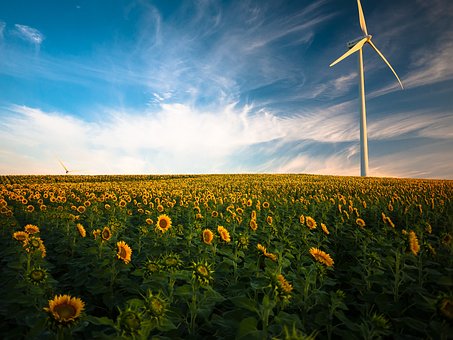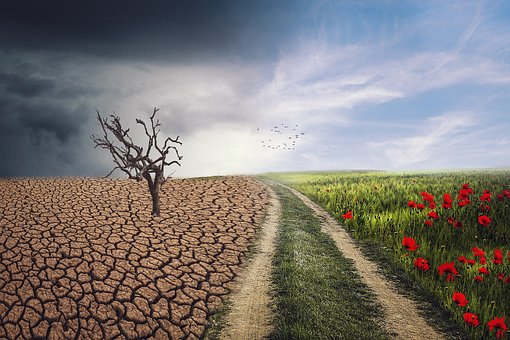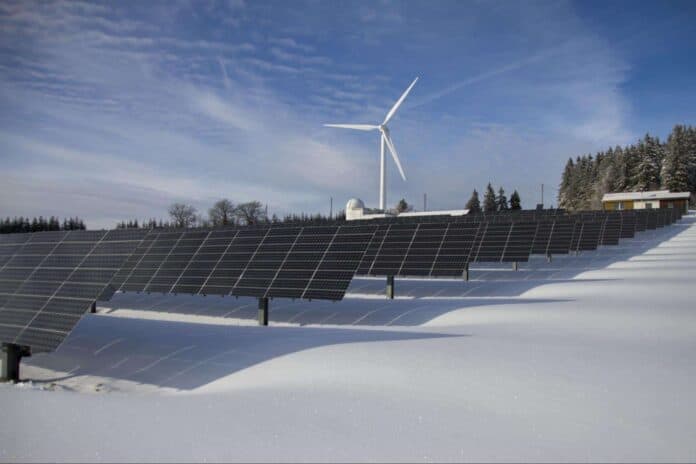Innovations in renewable energy have led to technology that is more accessible, affordable, and user-friendly than ever.
Renewables are an environmentally-friendly and economical alternative to fossil fuels, but how do different renewable energy sources compare?
Here, we’ll walk you through wind power and solar energy and the factors that determine which is more effective.

What is Wind Power?
Wind power comes from turbines that harness the wind to produce electricity. The turbines convert kinetic energy from the wind into mechanical power. Communities can immediately use that power for tasks such as pumping water or converting and storing it as electricity for later use.
While the popular image of a wind turbine is a towering structure over 200 feet (60m) tall, turbines are available in various sizes. The amount of energy produced correlates with the size of the turbine.
Smaller residential turbines, similar to solar panels, can provide all the power a home needs.
Advantages and Disadvantages of Wind Power
As with any technology, wind power has its benefits and drawbacks. Here are a few key considerations.
Pros
- Wind power reduces or eliminates fossil fuel dependency.
- The turbines allow for the capture of energy 24/7.
- As the wind power industry grows, it can bring communities high-quality jobs and economic growth.
- Turbines can harness power anywhere the wind blows, whether over rural land, water, or atop buildings.
Cons
- Wind power is not as cost-effective as solar for smaller-scale or residential properties.
- Turbines can interfere with local ecosystems and wildlife.
- Some people find turbines unsightly and noisy.
Cost and Efficiency of Wind Power
Wind turbines are between 20% and 40% efficient when generating usable electricity. That’s more efficient than solar panels, which have an average conversion efficiency of 15-20%. Some advanced solar panels can reach 23%.
That said, the conversion efficiency doesn’t account for the availability. Wind isn’t consistently available like sunlight is throughout the day. The conversion efficiency only accounts for the usable electricity generated with available resources.
Regarding long-term efficiency and lifespan, wind turbines typically last around two decades and require routine maintenance roughly every six months. The dependence on available wind and the level of maintenance may make some people turn to other renewable options.
The US Department of Energy stated that wind power costs are competitive with more conventional energy technologies. While the price of small-scale turbines is relatively high compared to kW output, they become more cost-effective as they grow in scale.
There are other factors to consider when considering the costs. For example, a site with more wind will produce cheaper energy than a less windy turbine location.
The Costs of Solar Panels vs Wind Turbines
Solar power is often the better option for homeowners and residential properties, while utilities often turn to wind power as their preferred renewable source. The different energy requirements are crucial when comparing the costs of solar panels and wind turbines.
On paper, wind power can appear to be the more affordable option. However, solar panels are far more accessible and easier to install on residential properties than turbines.
Smaller-scale turbines are available. However, they produce less energy, making residential turbines less cost-effective than their industrial counterparts. As such, solar is considered the more favourable choice for homeowners.
Environmental Impact of Wind Power
Renewable energy reduces reliance on fossil fuels. It’s excellent news for the battle against climate change. However, there are other environmental impacts to consider when deciding what renewable energy source is best.
Wind turbines don’t release emissions or require water for cooling. Plus, each turbine has a relatively small physical footprint, and the land surrounding the turbines is usable for other purposes, including agriculture.
However, it’s essential to consider the environmental impacts of wind power. The turbines are large machines that visually affect a landscape and create noise. Birds and bats often fly into the blades, which could contribute to the declining population of certain species.
Additionally, turbine construction requires many natural materials that involve large-scale resource extraction. Thankfully, researchers are searching for solutions to address these issues.
Wind energy, while not perfect, is still far more environmentally sound than fossil fuels.

What is Solar Energy?
The idea behind solar energy is similar to wind energy except that it uses electricity generated from sunlight. Photovoltaic panels convert sunshine into electricity and store it in a solar battery, like a portable power station, for future use.
Advantages and Disadvantages of Solar Energy
As with anything, there are pros and cons to solar energy. Here are some key considerations.
Pros
- Solar energy reduces reliance on fossil fuels.
- Solar energy is highly cost-effective and can lead to substantial energy savings.
- Solar panels are easy to install on homes and provide energy independence to families.
- Overall, maintenance costs for solar panels are low.
Cons
- Solar panels can only capture and produce energy when there is sunshine.
- There may be high upfront costs to purchase and install panels.
- PV technology requires resource extraction, which can harm ecosystems.
Environmental Impact of Solar Energy
As a renewable energy source, solar power is vital in reducing fossil fuel dependency. In this way, solar energy has helped reduce greenhouse gas emissions contributing to climate change. Additionally, solar requires little water to produce energy and can contribute to improved air quality.
But like wind power, solar energy has room for improvement, especially regarding solar’s environmental impact. Solar panels require an assortment of metals in their construction, which are energy-intensive and require mining.
Additionally, photovoltaic cells may require hazardous chemicals in the manufacturing process. These chemicals can cause problems for local ecosystems and wildlife if not handled responsibly. Land clearing for the placement of large-scale industrial solar farms can also harm harmful effects on native plants and animals.

How Do Wind Power and Solar Energy Contribute to Mitigating Climate Change?
The science is clear: to stave off the worst consequences of climate change, the global community must reduce fossil fuel emissions by nearly 50% by 2030 and reach net zero by 2050. Renewable energy technologies will be vital in achieving net zero in the next quarter century.
As more renewable technologies become more prevalent, countries can shift away from deadly fossil fuels. Switching to renewables can mitigate climate change and help build a safer world for all people, animals, and ecosystems.

Conclusion
While no technology comes without risks, renewable energy technologies are far less dangerous to people and planetary health than fossil fuels. Wind power may be a better option for large-scale utilities, while solar technology makes more sense for residential consumers. Ultimately, we need a variety of renewable technologies at play to successfully kick the fossil fuel habit.
Any shift toward renewable technology is a step in the right direction.

Frequently Asked Questions
Wind makes the blades of a turbine spin, which mechanically produces energy that the turbine harnesses and converts into electricity.
Solar panels capture the sun’s rays, and a portable power station or other balance of system converts the solar energy into AC electricity to use or store for future consumption.
At a large-scale, wind energy can be cheaper than solar. However, solar energy is more affordable for residential installations and smaller-scale consumers. Location also influences the cost. For example, solar power is likely cheaper per kWh and more efficient in an area with a lot of sunshine but little wind.
The main disadvantage of wind power is that it is not readily accessible or cost-effective for residential properties. The main disadvantage of solar power is that a system can only generate solar power when the sun is shining and the panels are free from obstruction.
One technology is not necessarily better than the other. Ultimately, u0022betteru0022 depends on your needs and perspective. Solar may be the better choice if you’re trying to find a residential solution. If you’re a commercial utility, wind may be best. Where you live and your reliable access to wind or sun also make a difference.
Wind turbines can be harmful to birds and wildlife. However, wind power reduces reliance on fossil fuels. Fossil fuel extraction and emissions are incredibly detrimental to wildlife. Comparing the two, wind turbines are far less harmful.
Solar farms that take up large swaths of land can harm birds and wildlife. However, you can install solar panels harmoniously with nature. In some cases, they can promote plant growth or provide shade for animals. Solar panels pose far less risk to nature and wildlife than fossil fuels.
